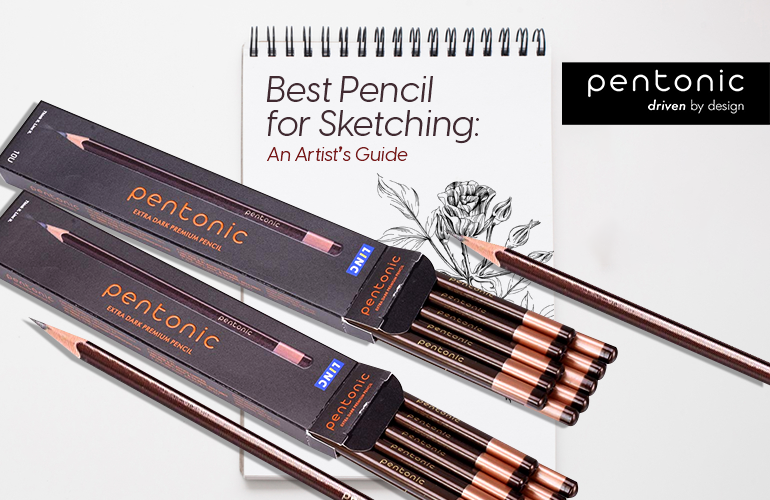Choosing the Best Pencil for Sketching: An Artist’s Guide


When it comes to sketching, the pencil you choose can significantly impact your artwork. From creating soft, delicate shading to bold, dramatic strokes, different pencils serve different purposes. This guide will help you explore the essentials of drawing pencils, understand various types, and discover which is the best sketching pencil that suits your artistic style, with a special spotlight on the versatile Pentonic Pencil, an ideal choice for sketching and also a reliable tool for everyday tasks.
Exploring the Basics of Drawing Pencils
Drawing pencils are a cornerstone of an artist's toolkit. Unlike standard writing pencils, they are specifically designed for sketching, offering a range of tones and textures. Different sketching pencil types allows for fine details, vivid strokes, and everything in between. Understanding pencil grades, from hard (H) to soft (B), is fundamental. Hard pencils create lighter, more precise lines, while soft pencils are perfect for rich, dark shading.
Sketching Pencil Types: What Every Artist Needs to Know
Not all sketching pencils are created equal, and knowing the different types will help you choose the right one for your artistic needs. Below are the most common types used by artists:
Each type has unique properties that cater to specific styles and techniques.
Graphite Pencils
Graphite pencils for sketching are the most popular choice among artists. They come in a wide range of grades, typically marked from 9H (hardest) to 9B (softest).
- Uses: Ideal for detailed work, realistic sketches, and smooth shading.
- Advantages: Versatile and easy to use. They can create both light and dark tones with smooth transitions.
For beginners, starting with a set that includes HB, 2B, 4B, and 6B pencils is a great way to experiment with various tones. The Pentonic Pencil meets all these criteria. Its sleek design and reliable performance make it a must-have in every artist’s toolkit.
Charcoal Pencils
Charcoal pencils are known for their rich, deep blacks and dramatic strokes. They come in three main forms: hard, medium, and soft.
- Uses: Best for bold, expressive drawings and high-contrast artwork.
- Advantages: Excellent for creating depth and texture. They blend well but require careful handling due to their brittleness.
Artists often pair charcoal drawing pencils with blending stumps or erasers to refine their sketches.
Coloured Pencils and Pastel Pencils
Coloured pencils and pastel pencils bring vibrancy and life to sketches.
- Uses: Perfect for adding colour, highlights, or creating mixed-media artworks.
- Advantages: Coloured pencils are versatile and easy to layer, while pastel pencils offer a soft, chalk-like texture.
When working with pastel pencils, a fixative spray is essential to preserve the artwork. Using coloured pencils can sometimes enhance artworks made by graphite pencils.
Mechanical Pencils
Mechanical pencils are favoured for their precision and convenience. Unlike traditional pencils or charcoal pencils, they don’t require sharpening.
- Uses: Ideal for detailed work, architectural sketches, and technical drawings.
- Advantages: Consistent line width and long-lasting. They are perfect for clean, intricate designs.
Mechanical pencils are especially useful for artists who value precision and portability.
Tips for Maintaining and Using Your Sketching Pencils
- Sharpening: Use a high-quality sharpener to maintain the tip and avoid unnecessary breakage.
- Storage: Store pencils in a case to prevent damage and keep them organized, especially for charcoal & mechanical pencils.
- Blending: Use blending tools like stumps or tissues instead of fingers to avoid smudging.
- Layering: Experiment with light layers and gradually build up for a more polished look.
- Fixatives: Protect your work with a fixative spray, especially when using charcoal or pastel pencils.
How to Use Graphite Pencils for Sketching
Graphite pencils are incredibly versatile and suitable for various techniques:
- Shading: Use the side of the pencil for smooth gradients.
- Hatching: Create parallel lines to add texture and tone.
- Burnishing: Layer and blend for a polished, glossy finish.
- Details: Use hard pencils for intricate lines and soft pencils for shadows.
Experimenting with different techniques and colouring with coloured pencils will enhance your ability to create depth and realism.
Comparing Sketching Pencil Types: Graphite vs. Charcoal
While both graphite and charcoal pencils are excellent for sketching, their characteristics differ:
- Graphite: Offers smooth transitions, is less messy, and is easier to erase. Ideal for detailed, realistic artwork.
- Charcoal: Provides rich, dramatic tones and is perfect for bold, expressive drawings. It requires more care in handling due to its fragility.
Artists often use both in tandem, with graphite for detailed work and charcoal for bold accents and depth.
Conclusion
Choosing the right pencil for sketching depends on your style, preferences, and the artwork you aim to create. From the precision of mechanical pencils to the dramatic strokes of charcoal, each type has its strengths. Experiment with various pencils, practice different techniques, and discover what works best for you. With the right tools and skills, the possibilities are endless!
Whether you're a budding artist or a seasoned professional,The Pentonic Pencil combines excellent graphite performance with a robust wood casing, ensuring a seamless experience for writers and artists alike. Whether you’re assembling your school stationery kit or upgrading your office supplies, investing in quality wood pencils is essential. Happy sketching!





Leave a Reply